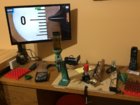I have been on a quest to improve the accuracy of my powder charges. Not quite ready to drop the $$ for the high end system. My steps include:
- I have 2 RCBS Chargemaster 1500 to work with. I would set the throw 0.1 gr light, transfer into my beam scale pan and trickle until the beam balanced. I could see the movement from a single granule of powder on my computer screen. HOWEVER, after the scale balanced, I would lightly touch the pan (up a small amount, then down a small amount) and the scale would not return to the -0 position. For the movement up, it would return short of coming to -0 after it was under the -0 mark. And the reverse for the other movement. I attributed it to the friction of the knife edges. Tried it on two different beam scales, similar result.
Then I watched the Eric Cortina video where he had an alternate method to try to attain improved accuracy from his Chargemaster. He had a scale that would provide accurate measurement to assess his improvement.
https://bulletin.accurateshooter.com/2015/05/cortinas-corner-chargemaster-tips-the-trickle-test/
My trickler "sucked" anyway, so I got the Dandy trickler he was using. Wow what an improvement. No more removing powder granules with tweezers. And since I had two Chargemasters, I throw 0.2 gr. light on the first one and transfer to the second one. First thing I learned is how bad the dispensed charge accuracy is from a Chargemaster. Now is my first scale reading correct, or the second? I am looking for consistency, not absolute. So by slowly adding granules and waiting for the second to read, I feel I have achieved improvement. My ES and SD are less. And I can fill cases at the same speed as I did before using just one scale.
Once your scale balances, I would be interested in you making the beam move the small amount I did, and see if yours balances on -0 again. I would have it move up (or down) enough so the pointer went about 2 graduations above (or below) the -0, but would not come up to the -0 from below. Not 3 swings, just 2.











